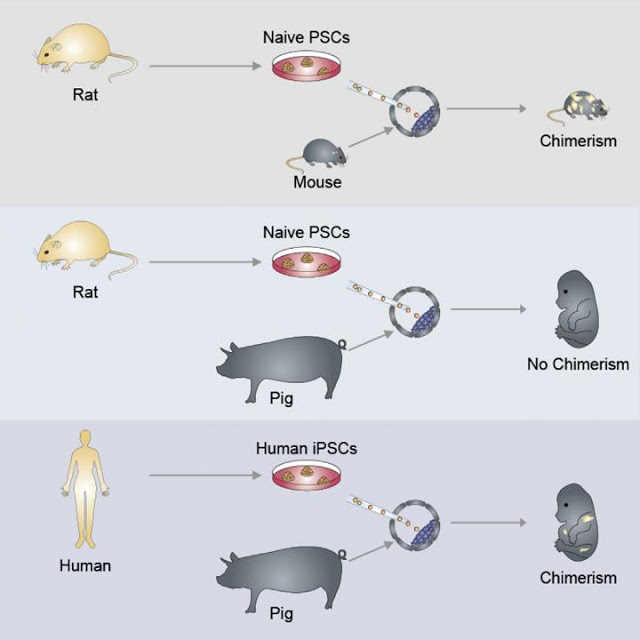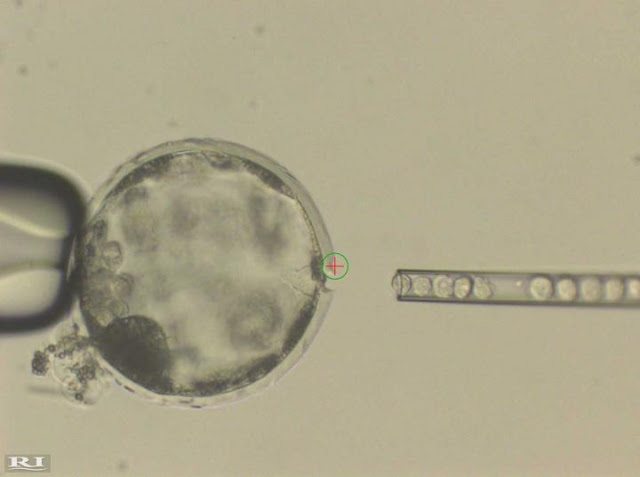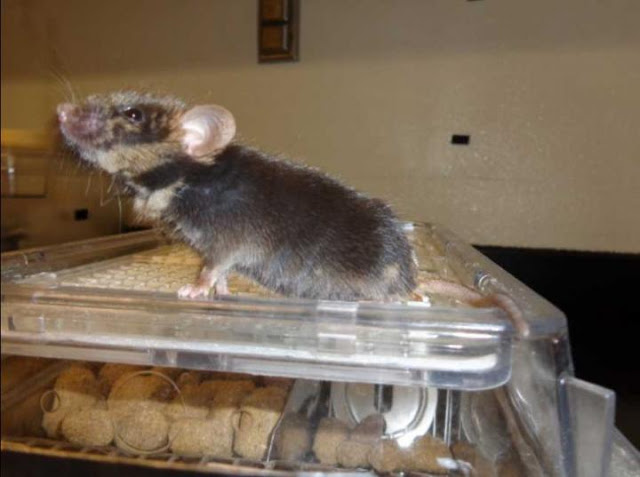

| Online: | |
| Visits: | |
| Stories: |

| Story Views | |
| Now: | |
| Last Hour: | |
| Last 24 Hours: | |
| Total: | |
Human/Pig Chimera Embryos Created Using Stem Cells
“The ultimate goal is to grow functional and transplantable tissue or organs, but we are far away from that,” says lead investigator Juan Carlos Izpisua Belmonte, a professor in the Salk Institute of Biological Studies’ Gene Expression Laboratory. “This is an important first step.”
This visual abstract depicts the findings that human pluripotent stem cells robustly engraft into both bovine and porcine preimplantation blastocysts, but show limited chimeric contribution to postimplantation pig embryos.

Credit: Wu et al./Cell 2017
As a first step, Izpisua Belmonte and Salk Institute staff scientist Jun Wu created a rat/mouse chimera by introducing rat cells into mouse embryos and letting them mature. Other researchers had already created a rat/mouse chimera in 2010. That chimera was a mouse with pancreatic tissue formed from rat cells.
Izpisua Belmonte and Wu built on that experiment by using genome editing to flexibly direct the rat cells to grow in specific developmental niches in the mouse. To accomplish this, they used CRISPR genome editing tools to delete critical genes in fertilized mouse egg cells. For instance, in a given cell, they would delete a single gene critical for the development of an organ, such as the heart, pancreas, or eye. Then, they introduced rat stem cells into the embryos to see if they would fill the open niche. “The rat cells have a functional copy of the missing mouse gene, so they can outcompete mouse cells in occupying the emptied developmental organ niches,” says Wu. As the organism matured, the rat cells filled in where mouse cells could not, forming the functional tissues of the organism’s heart, eye, or pancreas.
Rat cells also grew to form a gall bladder in the mouse, even though rats stopped developing this organ themselves over the 18 million years since rats and mice separated evolutionarily. “This suggests that the reason a rat does not generate a gall bladder is not because it cannot, but because the potential has been hidden by a rat-specific developmental program,” says Wu. “The microenvironment has evolved through millions of years to choose a program that defines a rat.”
This photograph shows injection of human iPS cells into a pig blastocyst. A laser beam (green circle with a red cross inside) was used to perforate an opening to the outer membrane (Zona Pellucida) of the pig blastocyst to allow easy access of an injection needle delivering human iPS cells.

Courtesy of Juan Carlos Izpisua Belmonte
Experiments with cow embryos were more difficult and costly than pigs, so the team zoomed in on pigs. The effort required to complete studies of 1,500 pig embryos involved the contributions of over 40 people, including pig farmers, over a four-year period. “We underestimated the effort involved,” says Izpisua Belmonte. “This required a tour de force.”
Not only are pigs and humans about five times more distant evolutionarily than mice and rats, but pigs also have a gestation period that is about one-third as long as humans, so the researchers needed to introduce human cells with perfect timing to match the developmental stage of the pig. “It’s as if the human cells were entering a freeway going faster than the normal freeway,” says Izpisua Belmonte. “If you have different speeds, you will have accidents.”
The researchers injected several different forms of human stem cells into pig embryos to see which would survive best. The cells that survived longest and showed the most potential to continue to develop were “intermediate” human pluripotent stem cells. So-called “naïve” cells resemble cells from an earlier developmental origin with unrestricted developmental potential; “primed” cells have developed further, but still remain pluripotent. “Intermediate cells are somewhere in between,” says Wu.
This photograph shows a 1-year-old chimera generated by injecting rat pluripotent stem cells (PSCs) into mouse blastocyst. Brown coat color indicates rat contribution.

Courtesy of Juan Carlos Izpisua Belmonte
The human cells survived and formed a human/pig chimera embryo. Embryos were implanted in sows and allowed to develop for between three and four weeks. “This is long enough for us to try to understand how the human and pig cells mix together early on without raising ethical concerns about mature chimeric animals,” says Izpisua Belmonte.
Even using the most well-performing human stem cells, the level of contribution to the chimerized embryo was not high. “It’s low,” says Wu.
Izpisua Belmonte considers this good news. One concern with the creation of human/animal chimeras is that the chimera will be too human. For instance, researchers don’t want human cells to contribute to the formation of the brain.
In this study, the human cells did not become precursors of brain cells that can grow into the central nervous system. Rather, they were developing into muscle cells and precursors of other organs. “At this point, we wanted to know whether human cells can contribute at all to address the ‘yes or no’ question,” he says. “Now that we know the answer is yes, our next challenge is to improve efficiency and guide the human cells into forming a particular organ in pigs.”
To do this, the researchers are using CRISPR to perform genome editing on the pig genome, as they did with mice, to open gaps that human cells can fill in. The work is in progress.
This research study was supported by The Fundación Séneca in Murcia, Spain, the Universidad Católica San Antonio de Murcia (UCAM), the Fundacion Dr. Pedro Guillen, the G. Harold and Leila Y. Mathers Charitable Foundation, and The Moxie Foundation.
Citation: Cell, Wu et al.: “Interspecies chimerism with mammalian pluripotent stem cells.” http://www.cell.com/cell/fulltext/S0092-8674(16)31752-4
Source:




Mad “scientists” trying to play Creator usually with devastating results as they not as intellectual as they would have you believe, more like mad experimentalists!